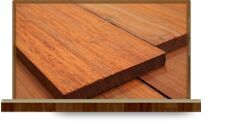
Padauk Wood
Get Price Quote
Details Heartwood color can vary, ranging from a pale pinkish orange to a deep brownish red. Most pieces tend to start reddish orange when freshly cut, darkening substantially over time to a reddish/purplish brown (some lighter pieces age to a grayish brown). See the article Preventing Color Changes in Exotic Woods for more information. Grain/Texture: Grain is usually straight, but can sometimes be interlocked. With a coarse, open texture and good natural luster. Endgrain: Diffuse-porous; large pores in no specific arrangement; solitary and radial multiples of 2-3; mineral deposits occasionally present; growth rings indistinct; rays not visible without lens; apotracheal parenchyma diffuse-in-aggregates, banded; paratracheal parenchyma aliform (winged), confluent, and banded. Rot Resistance: Has excellent decay resistance, and is rated as durable to very durable. Padauk is also reported to be resistant to termites and other insects. Workability: Overall Padauk is easy to work; tearout may also occur during planing on quartersawn or interlocked grain. Padauk turns, glues, and finishes well. Odor: Padauk has a faint, pleasing scent while being worked. Allergies/Toxicity: Although severe reactions are quite uncommon, Padauk has been reported as a sensitizer. Usually most common reactions simply include eye, skin, and respiratory irritation. See the articles Wood Allergies and Toxicity and Wood Dust Safety for more information. Pricing/Availability: Widely imported as lumber in a variety of lengths and thicknesses, as well as turning and craft blanks. Should be moderately priced for an import. Sustainability: This wood species is not listed in the CITES Appendices or on the IUCN Red List of Threatened Species. Common Uses: Veneer, flooring, turned objects, musical instruments, furniture, tool handles, and other small specialty wood objects. PRODUCT SUMMARY Padauk has a very unique reddish orange coloration, and the wood is sometimes referred to by the name Vermillion. Unfortunately, this dramatic color is inevitably darkened to a deep reddish brown color. (See the article Preventing Color Changes in Exotic Woods for more information.) UV-inhibiting finishes may prolong, but not prevent the gradual color-shift of this brightly colored wood. Padauk is moderately heavy, strong, and stiff, with exceptional stability. It’s a popular hardwood among hobbyist woodworkers because of its unique color and low cost. Padauk is perhaps the most frequently misspelled (and mispronounced) wood species, with Padouk, Paduk, and Paduak being common misspellings. The most common pronunciation is pah-DUKE, it is sometimes mispronounced as Paducah—a city in Kentucky.

Padauk Wood
Get Price Quote
Padauk wood is obtained from several species of Pterocarpus. All padauks are of African or Asian origin. Padauks are valued for their toughness, stability in use, and decorativeness, most having a reddish wood. Most Pterocarpus woods contain either water- or alcohol-soluble substances and can be used as dyes. The padauk found most often is African Padauk from Pterocarpus soyauxii which, when freshly cut, is a very bright red but when exposed to sunlight fades over time to a warm brown. Its colour makes it a favourite among woodworkers. Burmese Padauk is Pterocarpus macrocarpus while Andaman Padauk is Pterocarpus dalbergioides. Padauks can be confused with rosewoods to which they are somewhat related, but as a general rule padauks are coarser and less decorative in figure.
Best Deals from Padauk Wood

Padauk Wood
Get Price Quote
African Padauk wood lumber is used in fine joinery, fancy turnery, carvings, flooring, decorative veneer, tool and knife handles. Padauk wood may sometimes be confused with Rosewood but it is coarser and less decorative in figure. APPEARANCE: Heartwood vivid red when freshly cut darkening to a purple brown on exposure; sapwood 4 to 8 in. wide, whitish to brown yellow, distinct. Texture coarse; grain straight to interlocked; lustrous; faint aromatic scent when freshly cut DENSITY: Janka scale hardness is 1,630 for dry material WEIGHT: 51 lbs. / cu. ft., or approximately 4.25 lbs. per board foot DRYING: Dries very well with a minimum of degrade WORKABILITY: Saws well but requires slow feed, easy to machine but with some tearing of interlocked grain, takes a good finish, glues easily and holds nails and screws satisfactorily DURABILITY: Heartwood is very durable and very resistant to termite attack. Excellent weathering properties PRESERVATION: Heartwood fairly resistant to preservative treatments; sapwood moderately resistant FINISHING: Finishes well

Padauk Wood
Get Price Quote
Padauk wood is obtained from several species of Pterocarpus. All padauks are of African or Asian origin. Padauks are valued for their toughness, stability in use, and decorativeness, most having a reddish wood.

Padauk Wood
Get Price Quote
We have padauk wood for sales

Padauk Wood
Get Price Quote
Padauk Wood, Timber Logs, Teak Wood

Padauk Wood
Get Price Quote
Padauk Wood, Teak Wood, keledang wood, brown palm wood, Wenge Wood

Padauk Wood
Get Price Quote
Padauk Wood, Ghana Teak Wood

Padauk Wood
Get Price Quote
Padauk Wood, African Teak Wood, wood panels, Wood Logs, teak wood panels

Padauk Wood
Get Price Quote
Padauk Wood, Teak Wood, Tali Wood, Timber

Padauk Wood
Get Price Quote
Padauk Wood, Temple Chariot

Padauk Wood
Get Price Quote
Padauk Wood, Ghana Teak Door / African Teak Wood Door, Adhesives, Laminates

padauk
Get Price Quote
padauk, PURPLE HEART, beech, Wooden Doors, Wooden Log, poplar logs, Pine

Padauk Wood
Get Price Quote
Padauk Wood, Panel Door, Teak Wood Table, teak wood chair, Timber Wood Log

padauk
Get Price Quote
padauk, wooden pallets, wooden edge glued boards, Wooden Boxes, Wood